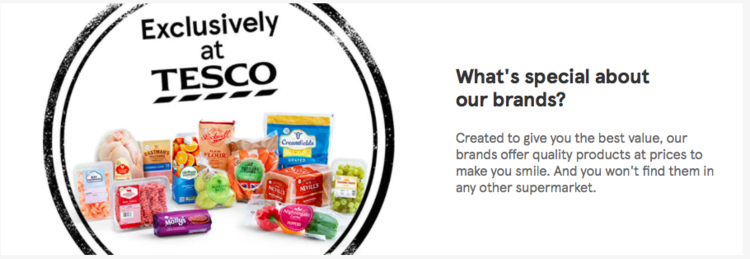Developing a future-proof strategy for own label
The Challenge
It is 2016 and the UK’s largest supermarket is having a turbulent time. Tesco is trading in the large and fiercely competitive £100billion UK grocery market, and its leadership position is under sustained and serious attack.
Shopper habits, which had begun to change during the recession, are now being accelerated by the growth in new technology and the arrival of some formidable new competitors, most notably in the form of Aldi and Lidl.
The ‘discount retailers’ are making ground in the value space, the other big supermarkets are aggressively targeting Tesco’s core business, and more upscale brands like Waitrose and M&S are winning a larger share of the premium segment.
Against this context, many of the things that had once helped Tesco ‘win’ with shoppers were losing their appeal; this problem is also being exacerbated by damage to their corporate reputation sustained as a result of the horse-meat scandal and serious accounting irregularities. It is starting to feel like ‘every little helps’ is more akin to a corporate mantra than a customer promise.
As the largest player in the market, Tesco appears vulnerable from every angle. Understanding how to deal with this competitive challenge went to the very core of the business and thus right to the heart of the own-label strategy.
What own-label strategy should Tesco adopt to counter this multitude of threats?
Where should it focus? How should it structure its portfolio of brands? And what did it need to do in order to reignite shopper interest?
The Approach
We knew from the outset that we would have access to large amounts of data, but the need to quickly provide the business with a new perspective would mean that we would need to lean heavily on our re-sight capability – reviewing and distilling data from a huge range of different sources.
We developed an agile approach designed to make the best use of the available qualitative and quantitative data, and we supplemented this understanding with our own desk research and category expertise.
Our ability and confidence to work with large data sets made a significant contribution to this project.
In order to identify the solution we combined a deep understanding of how shopping habits were changing with a robust analysis of switching habits and category performance. Later, we were able to utilise our understanding of how shoppers behave across categories, to make specific recommendations on how the overall offer should be structured, and how the portfolio of brands should be organised and deployed.
The Solution
Analysis
An initial review of the data revealed that Tesco’s issue wasn’t frequency of visit; the real issue was that when customers visited, they were spending less.
Volume, spend per buyer, spend per trip and average price were all moving in the wrong direction. Our next task was to understand why this was happening and what Tesco could do about it.
The data revealed that winning the shopper (the historic focus of the business) was not enough, they needed to win the shop.
The time when customers would buy all of their groceries at their preferred supermarket in a weekly or fortnightly shop was over. A rise in competitors, convenience formats, online, smaller households and smaller baskets, meant that people were shopping in a completely different way.
Against this context, competitors like Aldi and Lidl were also disrupting the traditional trade off between price and quality. By reducing the quantity of products in store (and simplifying choice), Aldi and Lidl were able to offer both good quality and incredibly low prices.
Customers were no longer choosing to trade up or down within the confines of a single supermarket’s offer; they were now effectively trading across supermarkets.
All of this meant that at Tesco customers were simply moving out of the value range into core and then frequently choosing to place their incremental spend with Aldi and Lidl. And the news wasn’t any better at the premium end of the offer, the simple truth was that others were ‘doing premium’ better – reputation issues and the subsequent erosion of consumer confidence were further compounding this issue.
We were able to unequivocally demonstrate to Tesco that the way people shopped for groceries had profoundly and fundamentally shifted. It was no longer enough to simply win the shopper, the new rules dictated that you had to win the shop.
Strategy into action
Informed by our initial analysis, we started by developing ‘10 provocations’, customer specific insights designed to push thinking inside Tesco and unlock opportunity. Most notable among these were:
- The importance of making customer’s lives easier
- Extending the idea of ‘every little helps’ beyond just price and promotion
- Better understanding different shopper missions in order to develop category hero’s and sharpen the distinction between ‘Better’ and ‘Best’
- Developing a series of more focused and targeted branded propositions
- Developing a more distinctive offer in fresh food
Having challenged the business to think about the overall shopper context we then turned our attention to the own-label strategy.
Sharpening the tiers
Our key recommendation was the need to revisit the overall tier strategy; the way the overall offer was deployed and presented.
We believed that ‘Good, Better, Best’ (value, core and premium) was still a helpful construct for customers, but the way it was being deployed needed to be fundamentally revisited so that it was better able to met the needs of today’s grocery shopper and counter the competitive threat posed by Aldi and Lidl.
We recommended that Tesco move away from the Everyday Value range as it was predicated on a set of ‘2D’ market assumptions (price vs. quality) that were no longer valid.
Grocery shopping was now being played out in ‘3D’ – simplified choice, great quality and incredibly low prices – Tesco needed to embrace this reality. It needed a simplified set of ‘brilliant basics’ that were available ‘Exclusively at Tesco.’

At the same time we also recommended that ‘Better’ (core) should focus on winning back core shopper missions by targeting ‘Waitrose quality at Lidl prices’. And ‘Best’ should focus on primarily food-driven categories, offering ‘extraordinary products’ that were seen as real rewards and treats by shoppers and their families.
All of this work was supported by robust analysis and together it provided a clear and actionable plan for Tesco to meet its competitive challenges head-on.
In Summary
This piece of work resulted in Tesco fundamentally overhauling its approach to own-label.
Tier levels were repurposed and a new suite of brands developed. The offer was sharpened in order to better meet the needs of the shopper and provide a more robust strategy to counter the competitive threat.
The own-label strategy became a cornerstone of Tesco’s push to ‘win the shop’ and reignite growth.
In April 2018 Tesco reported a UK market share of 27.6% and a profit increase of 28% over the prior year and CEO Dave Lewis was able to announce a 9th consecutive quarter of growth.
“More people are choosing to shop at Tesco and our brand is stronger, as customers recognise improvements in both quality and value.”
Dave Lewis, CEO Tesco
Food sales rose overall by 3% driven by increases in ‘fresh food and its own- branded products’. Grocery retailing is highly competitive and Tesco will continue to face pressures from all sides, but there is no doubt that Tesco is stronger for having a clear and actionable strategy based on a deep understanding of how customers shop and where they spend their money.
Image credits: Simon Haytack, Tesco website


